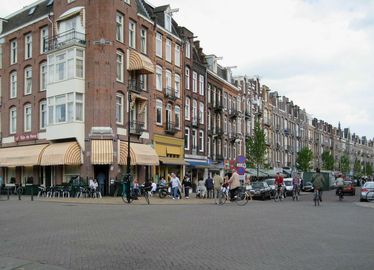

Thanks to the Java street, which remain a vital artery going through both the Dapper Buurt and the Indische Buurt, the Dapper and the Indische neighborhoods are sometimes referred to as one: the Java neighborhood. The street bears the name of the most important island in the Indonesian archipelago. As can be observed from the train platform above, the street curves slightly to the right, as also do the 1st Atjehstraat, the Balistraat and the Madurastraat. Here, in the oldest part of the Indischebuurt, the streets follow the pattern of the original polder allotment, as they also do, for example, in the Pijp neighborhood. In other parts of this district this had been resolved and the streets were laid out and connected at right angles.
Javastraat is the main shopping drag in the neighborhood, connecting the Dapper and the Indische sides, and features a wide variety of stores, restaurants and cafes. In the past these were mainly fashion stores, shoe shops, grocers, bakers and butchers. The shops were once strongly compartmentalized and everyone shopped at their 'own supplier’s’. Catholics bought from their own Roman Catholic grocer De Gruyter, while the Protestants largely preferred one of their own - Simon de Wit. Even the Socialists and the Communists had their very own 'cooperative shops’.
After the war this has changed dramatically and, fortunately, today the shoppers no longer draw such divisions. There is much to discover in the Java Street: from Turkish and Moroccan bakers to Volendam fishmongers, from Iranian and Pakistani grocers to Chinese and Surinamese hairdressers and, more recently, the returned of fashion and introduction of hip coffee places.
These days the rail tracks and the Muider Train Station divide the Dapper and the Indische neighborhoods. However, before the train viaduct was constructed in 1936, the Indische Buurt neighborhood was quite isolated and separated from the city. Due to the busy train route, the barriers were sometimes lowered for more than thirty minutes each hour and did not let anyone cross the tracks. The freight trains from the port also came through here since the Amsterdam port was then largely located at the Eastern Docklands. In 1905 a temporary pedestrian bridge was constructed over the rail tracks; however horses and carts were unable to use it.
The relief was great when it was decided to lift the train tracks by constructing several viaducts. The Alderman Monne de Miranda opened the ceremony by personally cutting an old wooden barrier with a saw. Under the viaduct there is a plaque commemorating this opening of the connecting tunnel and the subsequent ‘emancipation’ of the Indische Buurt.